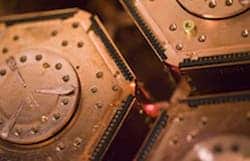Despite it makes up more than 85% of all matter in the Universe, dark matter, staying true to its name, has eluded scientists for decades ever since they’ve been trying to identify it with high power particle accelerators and detectors. Recent efforts seem to be paying off as various underground labs, as well as those in space, have reported hints of dark matter in their experiments. The most recent one comes from a lab buried deep within a mine in the US state of Minnesota, from where physicists report they have found three signals that suggest they’ve encountered dark matter. The researchers caution, however, that by no means they’re ready to announce they’ve found dark matter, as this is a claim that requires much deliberation and more precise measurements. We all remember the faster than light neutrinos from CERN, right?
The new results come from the Super Cryogenic Dark Matter Search (SuperCDMS), one of the few labs in the world that are tasked with investigating dark matter – a major constitutive part of the Universe which can not be seen or felt, but whose presence is most undeniable based on its gravitational effects on visible matter, radiation, and the large-scale structure of the universe. Understanding what it is and what kind of subparticles its made out of would come as a tremendous milestone in physics and will deepen our view on how the Universe formed, expands and where it might ultimately lead to.
“It’s certainly something we want to be investigating,” CDMS collaborator Blas Cabrera of Stanford University said.
“This is science, and the further tightening up of what we see – or excluding it – is very important for us to do.”
The hidden everything

Dark matter is believed to rarely interact with normal matter, and to even get a chance to catch a glimpse of it, special conditions need to be met. For instance, for the CDMS experiment, the scientists chilled germanium and silicon to incredibly cold temperatures such that they may form an environment where dark matter detection is possible since if a dark matter particle passes through, hitting a frigid atom nucleus, it releases charge and heat that the scientists can detect with supersensitive instruments.
This is exactly what happened, as not one, but three signals hinting towards such an event were detected. Their findings show that the signals they’ve detected are 99.81 percent more likely to be caused by a weakly interacting massive particle (WIMP) – particles that emit no light, but cause a gravitational effect, serving as a viable candidate for dark matter – instead of random signal fluctuations, which are believed to be detected only 5.4 percent of the time. Is this enough to announce in all hail of glory the discovery of dark matter? Not nearly. When the discovery of the higgs boson – the elementary particle that’s thought to grant all matter with mass – was announced at CERN, it was made based on findings that reported measurements in order of five-sigma or certainty of 99.99997%. Current dark matter signals are only three-sigma.
The finding “does not rise anywhere near the level of discovery, nor does it rise anywhere near what we would call ‘evidence for,'” Cabrera said. It is, however, a “region of interest” for future study.
Few places left ‘to run’ for dark matter
So far, preliminary results suggest that if the signal is indeed caused by a WIMP, then the inferring particle must have a mass that is about nine times that of the proton, one that is still consistent with some theories. In 2010, the same CDMS lab reported two hints of dark matter, but it was soon after found that the results were skewed by the instruments themselves. The hint-laden data were taken when CDMS used detectors made of silicon; it has since moved on to germanium detectors.
“There’s been an interesting back-and-forth between experiments,” says CDMS Spokesperson Blas Cabrera of Stanford University and SLAC National Accelerator Laboratory. To investigate this hint, “we’ll certainly need more data. If a signal persists, it will need to be replicated by other experiments with different technologies before it is accepted by the community.”
Dark matter might not have too places left to hide though, as multiple experiments and trying at the same time, using different methods, to pinpoint dark matter signals. Just last month, an important NASA announcement spoke of dark matter hints in measurements taken aboard the International Space Station. The detector, the Alpha Magnetic Spectrometer, detected 400,000 positrons, which are the antimatter “twins” of electrons. These particles may have been created when dark matter particles collided and annihilated each other.
The CDMS findings were announced at the recent meeting of the American Physical Society and are slated to be posted to the preprint server Arxiv.






